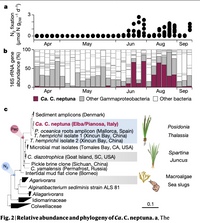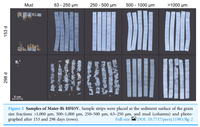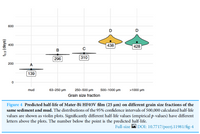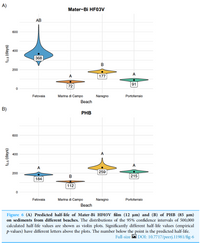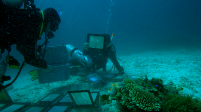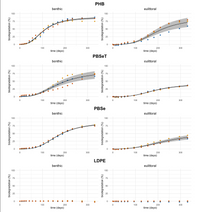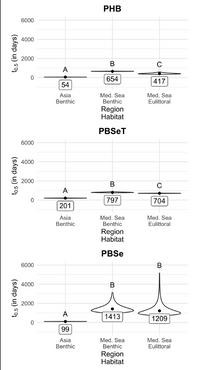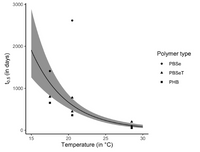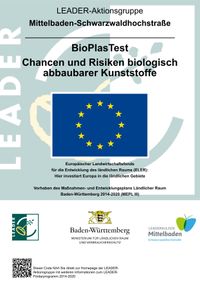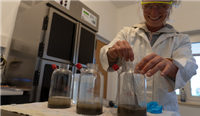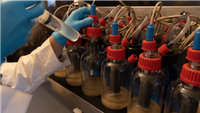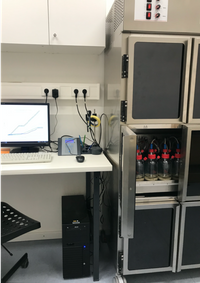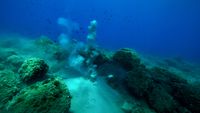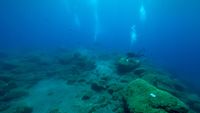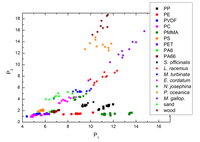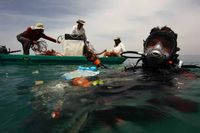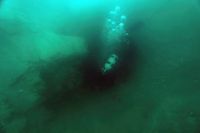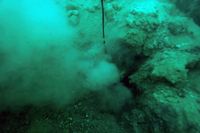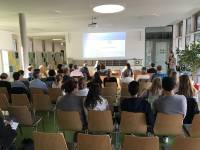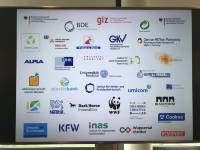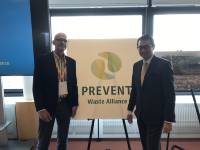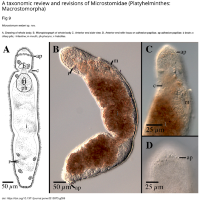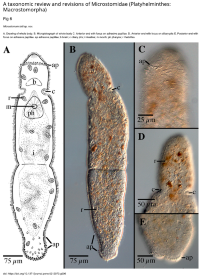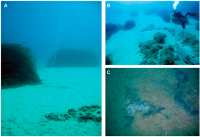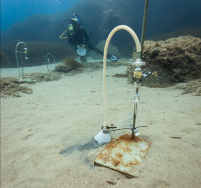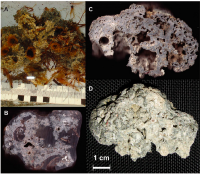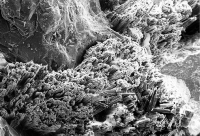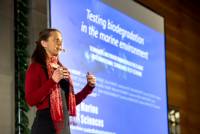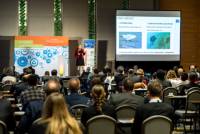News
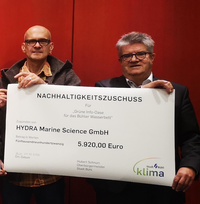
Sustainability Award by City of Bühl
Nachhaltigkeitszuschuss der Stadt Bühl
01 December 2022 The Major of Bühl, Hubert Schnurr and HYDRA's Co-Director Christian Lott at the 2022 Sustainability Award Ceremony (Photo: Stefan Karcher)
HYDRA local project awarded Our Initiative 'Green Info Oasis' received a prize of 5920 € as a financial support for our neighborhood project to make our former industry area greener. Right in front of our institute we will create a publicly accessible Green Info Oasis with an integrated meeting corner, a discover-nature desk and an interactive info panel. Over the next three years the project will grow and enrich Bühl's committment for a sustainable town, in the mixed neighborhood of the commercial and residential area 'Im Wasserbett'.
Lokales HYDRA Projekt ausgezeichnet Unsere Initiative "Grüne Info-Oase" erhielt einen Preis in Höhe von 5920 € als Teilfinanzierung unseres Nachbarschaftsprojekts, um unser ehemaliges Industriegebiet grüner zu gestalten. Direkt vor unserem Institut werden wir eine öffentlich zugängliche Grüne Info-Oase mit einer integrierten Begegnungsecke, einem Naturentdeckertisch und einer interaktiven Infotafel einrichten. In den nächsten drei Jahren wird das Projekt wachsen und Bühls Engagement für eine nachhaltige Stadt in der gemischten Nachbarschaft des Gewerbe- und Wohngebietes 'Im Wasserbett' bereichern.
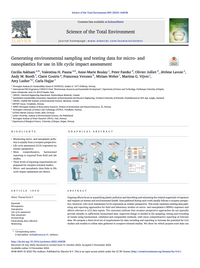
Plastic Life Cycle Impact Assessment
14 November 2022
Titel of the original publication Cecilia Askham, Valentina H. Pauna, Anne-Marie Boulay, Peter Fantke, Olivier Jolliet, Jérôme Lavoie, Andy M. Booth, Claire Coutris, Francesca Verones, Miriam Weber*, Martina G. Vijver, Amy Lusher, Carla Hajjar (2023) Generating environmental sampling and testing data for micro- and nanoplastics for use in life cycle impact assessment, Science of The Total Environment, Volume 859, Part, 2023,160038, doi.org/10.1016/j.scitotenv.2022.160038.
Abstract Ongoing efforts focus on quantifying plastic pollution and describing and estimating the related magnitude of exposure and impacts on human and environmental health. Data gathered during such work usually follows a receptor perspective. However, Life Cycle Assessment (LCA) represents an emitter perspective. This study examines existing data gathering and reporting approaches for field and laboratory studies on micro- and nanoplastics (MNPs) exposure and effects relevant to LCA data inputs. The outcomes indicate that receptor perspective approaches do not typically provide suitable or sufficiently harmonised data. Improved design is needed in the sampling, testing and recording of results using harmonised, validated and comparable methods, with more comprehensive reporting of relevant data. We propose a three-level set of requirements for data recording and reporting to increase the potential for LCA studies and models to utilise data gathered in receptor-oriented studies. We show for which purpose such data can be used as inputs to LCA, particularly in life cycle impact assessment (LCIA) methods. Implementing these requirements will facilitate proper integration of the potential environmental impacts of plastic losses from human activity (e.g. litter) into LCA. Then, the impacts of plastic emissions can eventually be connected and compared with other environmental issues related to anthropogenic activities.

Methane emissions from seagrass meadows
14 February 2022 published in PNAS
Title of the original publication Schorn S, Ahmerkamp S, Bullock E, Weber M*, Lott C*, Liebeke M, Lavik G, Kuypers MMM, Graf JS, Milucka J (2022) Diverse methylotrophic methanogenic archaea cause high methane emissions from seagrass meadows. Proceedings of the National Academy of Sciences, PNAS 2022 Vol. 119 No. 9 e2106628119, https://doi.org/10.1073/pnas.2106628119
N2-fixing symbionts in seagrass
03 November 2021 published in Nature
Title of the original publication Mohr W, Lehnen N, Ahmerkamp S, Marchant HK, Graf JS, Tschitschko B, Yilmaz P, Littmann S, Gruber-Vodicka H, Leisch N, Weber M*, Lott C*, Schubert CJ, Milucka J, Kuypers MMM (2021) Terrestrial-type nitrogen-fixing symbiosis between seagrass and a marine bacterium. Nature (2021). https://doi.org/10.1038/s41586-021-04063-4
Biodegradable plastic on different sands
10 August 2021 published in PeerJ
Titel of the original publication Eich A*, Weber M*, Lott C* (2021) Disintegration half-life of biodegradable plastic films on different marine beach sediments. PeerJ 9:e11981 DOI 10.7717/peerj.11981
Abstract The seafloor is considered the major sink for plastic debris in the world’s oceans. Biodegradable polymers are available on the market as a substitute for conventional plastic and could potentially end up in the same environment. To gain more insight into the effects of different sediments on the degradation rate of biodegradable plastic we performed two iterative seawater tank experiments. First, to test the effect of sediment grain size, film of Mater-Bi HF03V, a blend of thermoplastic starch and biodegradable polyesters, was placed on the surface of mud as well as on four different grain size fractions of beach sand. Disintegration half-life was shortest on mud (139 days) and increased with the grain size of the beach sediment fractions (63–250 μm: 296 days; 250–500 μm: 310 days; 500–1,000 μm: 438 days; >1,000 μm: 428 days). We assume that the higher surface-to-volume ratio in fine sediment compared to coarse sediment led to a higher bacterial abundance and thus to faster disintegration rates. In a follow-up experiment, the <500 μm fraction of sediment from four different beaches around Isola d’Elba, Italy, was used to test plastic disintegration as above. Additionally, polyhydroxybutyrate (PHB, MIREL P5001) was used as a positive control and high-density polyethylene (HD-PE) as a negative control. No disintegration was observed for HD-PE. Mater-Bi HF03V and PHB disintegrated significantly differently on sediment from different sites, with half-lives of Mater-Bi HF03V ranging from 72 to 368 days and of PHB from 112 to 215 days. Here, the half-life was shortest on slightly coarser sediment and at potentially anthropogenically impacted sites. We assume that the effect of the grain size on the disintegration rate was masked by other parameters influencing the microbial community and activity. Understanding the parameters driving biodegradation is key to reliably report the range of disintegration rates occurring under the various conditions in different ecosystems.
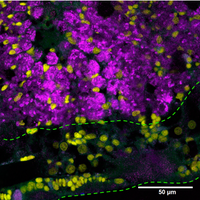
Symbionts named 'weberae' and 'lotti'
20 July 2021 Many thanks to our colleagues from the Max Planck Institute for Marine Microbiology in Bremen and the University of Vienna for naming two new symbiotic bacteria after HYDRA Marine Sciences directors Miriam Weber and Christian Lott. This is a special honor as it also reflects the intimate and fruitful symbiosis in research between our institutions for more than two decades! We have been collaborating for many years in the research of the symbioses of lucinid clams and bacteria and other topics and are looking forward to further exciting results. Congratulations to the article they published together with a global team of researchers on the worldwide distribution of Lucinidae bivalves and their associated bacterial symbionts.
Title of the original publication: Jay T. Osvatic, Laetitia G. E. Wilkins, Lukas Leibrecht, Matthieu Leray, Sarah Zauner, Julia Polzin, Yolanda Camacho, Olivier Gros, Jan A. van Gils, Jonathan A. Eisen, Jillian M. Petersen, Benedict Yuen. Global biogeography of chemosynthetic symbionts reveals both localized and globally distributed symbiont groups. Proceedings of the National Academy of Sciences, 2021; 118 (29): e2104378118 DOI: 10.1073/pnas.2104378118
Press release of the Max Planck Society: https://www.mpg.de/17167831/symbionten-ohne-grenzen-bakterielle-untermieter-bereisen-die-welt
Specific biofilm of microplastics
16 June 2021 published in Frontiers in Microbiology
Title of the original publication: Vaksmaa A, Knittel K, Abdala Asbun A, Goudriaan M, Ellrott A, Witte HJ, Vollmer I, Meirer F, Lott C*, Weber M*, Engelmann JC and Niemann H (2021) Microbial Communities on Plastic Polymers in the Mediterranean Sea. Front. Microbiol. 12:673553. doi: 10.3389/fmicb.2021.673553
Abstract Plastic particles in the ocean are typically covered with microbial biofilms, but it remains unclear whether distinct microbial communities colonize different polymer types. In this study, we analyzed microbial communities forming biofilms on floating microplastics in a bay of the island of Elba in the Mediterranean Sea. Raman spectroscopy revealed that the plastic particles mainly comprised polyethylene (PE), polypropylene (PP), and polystyrene (PS) of which polyethylene and polypropylene particles were typically brittle and featured cracks. Fluorescence in situ hybridization and imaging by highresolution microscopy revealed dense microbial biofilms on the polymer surfaces. Amplicon sequencing of the 16S rRNA gene showed that the bacterial communities on all plastic types consisted mainly of the orders Flavobacteriales, Rhodobacterales, Cytophagales, Rickettsiales, Alteromonadales, Chitinophagales, and Oceanospirillales. We found significant differences in the biofilm community composition on PE compared with PP and PS (on OTU and order level), which shows that different microbial communities colonize specific polymer types. Furthermore, the sequencing data also revealed a higher relative abundance of archaeal sequences on PS in comparison with PE or PP. We furthermore found a high occurrence, up to 17% of all sequences, of different hydrocarbon-degrading bacteria on all investigated plastic types. However, their functioning in the plastic-associated biofilm and potential role in plastic degradation needs further assessment.
Ocean Plastic: How long does it stay?
06 May 2021 published in Frontiers in Marine Science
Title of the original publication: Lott C*, Eich A*, Makarow D, Unger B, van Eekert M, Schuman E, Reinach MS, Lasut MT and Weber M* (2021) Half-Life of Biodegradable Plastics in the Marine Environment Depends on Material, Habitat, and Climate Zone. Front. Mar. Sci. 8:662074. doi: 10.3389/fmars.2021.662074
Abstract The performance of the biodegradable plastic materials polyhydroxybutyrate (PHB), polybutylene sebacate (PBSe) and polybutylene sebacate co-terephthalate (PBSeT), and of polyethylene (LDPE) was assessed under marine environmental conditions in a three-tier approach. Biodegradation lab tests (20°C) were complemented by mesocosm tests (20°C) with natural sand and seawater and by field tests in the warm-temperate Mediterranean Sea (12–30°C) and in tropical Southeast Asia (29°C) in three typical coastal scenarios. Plastic film samples were exposed in the eulittoral beach, the pelagic open water and the benthic seafloor and their disintegration monitored over time. We used statistical modeling to predict the half-life for each of the materials under the different environmental conditions to render the experimental results numerically comparable across all experimental conditions applied. The biodegradation performance of the materials differed by orders of magnitude depending on climate, habitat and material and revealed the impreciseness to generically term a material “marine biodegradable.” The half-life t0.5 of a film of PHB with 85 µm thickness ranged from 54 days on the seafloor in SE Asia to 1,247 days in mesocosm pelagic tests. t0.5 for PBSe (25 µm) ranged from 99 days in benthic SE Asia to 2,614 days in mesocosm benthic tests, and for PBSeT t0.5 ranged from 147 days in the mesocosm eulittoral to 797 days in Mediterranean benthic field tests. For LDPE no biodegradation could be observed. These data can now be used to estimate the persistence of plastic objects should they end up in the marine environments considered here and will help to inform the life cycle (impact) assessment of plastics in the open environment.
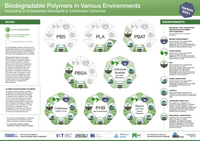
Overview Update: Biodegradable Polymers
21 April 2021 Biodegradable Polymers: Performance in Various Environments
Poster Update by nova-Institut GmbH
Experts from HYDRA together with colleagues from the Institut für Kunststofftechnik, Stuttgart (D) and Organic Waste Systems, Gent (B) were involved in the latest update of a reference poster published by our partner nova-Institut, Hürth (D). The poster compiles the currently available scientific information on the performance of the most common and industrially used biodegradable polymers in different managed and natural environments such as industrial compost, home compost, soil, freshwater or the marine environment. Although our knowledge is far from complete yet, this poster gives the most comprehensive summary of its kind in one graphical overview. For details and feedback please refer to Michael.Carus at nova-institut.de. The publication was sponsored by TÜV Rheinland/DIN Certco and TÜV Austria.
Free download from: https://renewable-carbon.eu/publications/
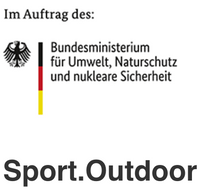
Dialogforum Sport.Outdoor
15 Dec 2020 On-line Symposium at the German Ministry of Environment
On invitation of the Advisory Board "Environment & Sports" to the Federal Ministry of Environment, Nature Conservation and Nuclear Safety HYDRA director Christian Lott was one of the expert speakers on "Microplastics from Sports in the Environment". His core topic was the possible role of biodegradable materials especially in the apparel sector, but also beyond as in sports arenas and sports equipment. He pointed out that it highly depends from case to case whether there will be a benefit from substitution, or where substitution might even be the only solution to mitigate environmental plastic pollution. However, measures such as to refuse, to reduce and to recycle must be seen in concert with re-designing plastic applications in sports and beyond. Find more information on https://www.impulsgebersport2020.de/praesentationen/
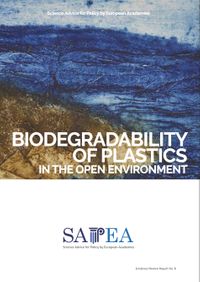
New Report: Biodegradability of Plastics
14 Dec 2020 Evidence Review Report handed over to European Commission
All our experience was brought into the collaborative work of compiling the Evidence Review Report on Biodegradability of Plastics in the Open Environment of SAPEA (Science Advice for Policy by European Academies) together with other experts from Europe. The peer-reviewed report was prepared on request from the European Commission and will help to inform decision makers on European level.
Title of the original publication:
Albertson A-C, Bødtker G, Boldizar A, Filatova T, Prieto Jimenez MA, Loos K, Poortinga W, Sander M, Seppälä J, Thompson R, Weber M* (2020)
Biodegradability of Plastics in the Open Environment. Berlin: SAPEA, Science Advice for Policy by European Academies. DOI10.26356/biodegradabilityplastics (peer reviewed report)
The full report can be found on the SAPEA website: https://www.sapea.info/topics/biodegradability-of-plastics/
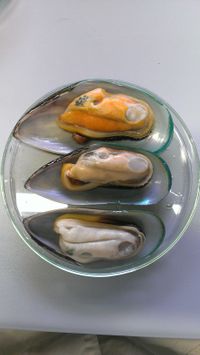
Microplastics in mussels for consumption
16 Dec 2020 published in Environmental Pollution
Title of the original publication: B.N. Vinay Kumar, Lena A. Löschel*, Hannes K. Imhof, Martin G.J. Löder, Christian Laforsch (2021) Analysis of microplastics of a broad size range in commercially important mussels by combining FTIR and Raman spectroscopy approaches. Environmental Pollution, Volume 269, 2021, 116147, https://doi.org/10.1016/j.envpol.2020.116147.
EU-Förderung für BioPlasTest
22 Oct 2020 Unterstützung aus dem LEADER-Programm zur Entwicklung des ländlichen Raums
Die HYDRA Marine Sciences GmbH aus Bühl erhält eine Förderzuwendung zur Einrichtung ihrer Forschungsstruktur, um in Zukunft noch präziser den biologischen Abbau von biologisch abbaubaren Kunststoffen in der Umwelt untersuchen zu können. Künftig können wir so mit dem automatisierten Laborinkubator SELUTEC BSBdigi das Abbauverhalten von Kunststoffen sowohl nach Standardverfahren (DIN, ISO, EN, ASTM etc.) untersuchen, als auch experimentell unter bisher nicht standardisierten Bedingungen forschen. Die Einrichtung unseres neuen Labors, mit dem Inkubator als Kernstück, wird im Rahmen des LEADER-Programms der Europäischen Kommission mit einem Zuschuss gefördert. Hiermit unterstützt die EU die Etablierung unserer internationalen Forschung im ländlichen Raum der Region Mittelbaden-Schwarzwaldhochstraße.
EU grant for our BioPlasTest project
22 Oct 2020 Partial funding from LEADER program for rural development
HYDRA Marine Sciences is receiving financial support for their research structure to enable a more detailed investigation of the biodegradation of biodegradable plastic materials in the open environment. With the automated incubator SELUTEC BSBdigi we now can study the performance of plastics as well according to standard methods (DIN, ISO, EN, ASTM etc.), as also experimentally under non-standard conditions. With their contribution, the EU under its LEADER program is supporting the establishment of our international research in our new facility in the rural region Mittelbaden-Schwarzwaldhochstrasse.
Submarine mud volcano discovered
22 Sep 2020 published in Applied Geochemistry
Title of the original publication: Saroni, A., Sciarra, A., Grassa, F., Eich*, A., Weber*, M., Lott*, C., Ferretti, G., Ivaldi, R., Coltorti, M. (2020) Shallow submarine mud volcano in the Northern Tyrrhenian sea, Italy. Applied Geochemistry, https://doi.org/10.1016/j.apgeochem.2020.104722.

Marine tests on plastic biodegradation
31 July 2020 published in PLoS ONE
The pollution of the natural environment, especially the world’s oceans, with conventional plastic is of major concern. Biodegradable plastics are an emerging market bringing along potential chances and risks. The fate of these materials in the environment and their possible effects on organisms and ecosystems has rarely been studied systematically and is not well understood. For the marine environment, reliable field test methods and standards for assessing and certifying biodegradation to bridge laboratory respirometric data are lacking. In this work we present newly developed field tests to assess the performance of (biodegradable) plastics under natural marine conditions. These methods were successfully applied and validated in three coastal habitats (eulittoral, benthic and pelagic) and two climate zones (Mediterranean Sea and tropical Southeast Asia). Additionally, a stand-alone mesocosm test system which integrated all three habitats in one technical system at 400-L scale independent from running seawater is presented as a methodological bridge. Films of polyhydroxyalkanoate copolymer (PHA) and low density polyethylene (LD-PE) were used to validate the tests. While LD-PE remained intact, PHA disintegrated to a varying degree depending on the habitat and the climate zone. Together with the existing laboratory standard test methods, the field and mesocosm test systems presented in this work provide a 3- tier testing scheme for the reliable assessment of the biodegradation of (biodegradable) plastic in the marine environment. This toolset of tests can be adapted to other aquatic ecosystems.
Title of the original publication: Lott C*, Eich A*, Unger B, Makarow D, Battagliarin G, Schlegel K, Lasut MT, Weber M* (2020) Field and mesocosm methods to test biodegradable plastic film under marine conditions. PLoS ONE 15(7): e0236579. https://doi.org/10.1371/journal.pone.0236579
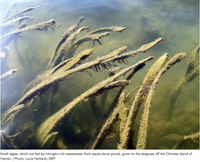
Too much for seagrass meadows
17 July 2020 published in Marine Environmental Research
Seagrasses are important ecosystem engineers in coastal marine areas worldwide and suffer from multiple effects of increasing urbanization. HYDRA collaborator Esther Thomsen and colleagues from the German Centre for Tropical Marine Ecology (ZMT, Bremen) could identify the threshold of environmental stressors, especially of nitrogen compounds from wastewater and aquaculture run-off at Hainan/China, during her Ph.D. studies. ZMT team leader Tim Jennerjahn points out that this study is the first to determine a threshold for nitrogen compounds above which seagrass habitats cannot recover from this environmental stress anymore and die off.
Title of the original publication: Esther Thomsen*, Lucia S. Herbeck, Tim C. Jennerjahn (2020) The end of resilience: Surpassed nitrogen thresholds in coastal waters led to severe seagrass loss after decades of exposure to aquaculture effluents. Marine Environmental Research, Volume 160, 2020, 104986, doi.org/10.1016/j.marenvres.2020.104986.
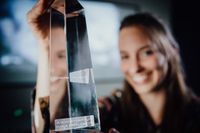
Dunja Engelbrecht ausgezeichnet
29 Mai 2020 Vom Praktikum zum Deutschen Kamerapreis 2020
Für Ihre Kameraarbeit zu der MDR/ARTE-Produktion 'Holzkohle Adé - Polens Köhler vor dem Aus' erhält Dunja Engelbrecht den Deutschen Kamerapreis 2020 in der Kategorie Dokumentation. Dunja ist freie Kamerafrau und hat nach Ihrem Studium bei uns zunächst ein Praktikum mit dem Schwerpunkt Natur- und Umweltdokumentation absolviert, um dann beim Hessischen Rundfunk ihre Ausbildung zur Kamerafrau abzuschließen. Seither war Dunja mit uns an großen internationalen Dokumentarfilmprojekten am Mittelmeer, am Amazonas und in der Karibik beteiligt. Wir gratulieren Dunja zu dieser großartigen Auszeichnung. Wir haben's schon immer gewusst - jetzt ist es amtlich: Großes Kino!! Mehr Infos unter 2020.deutscher-kamera-preis.de --------- For her camera work on the MDR/ARTE production 'Bye-bye Charcoal - Poland's charburners before the end' Dunja Engelbrecht receives the German Camera Award 2020 in the category Documentary. Dunja is a freelance cinematographer and after her studies she first completed an internship with us with the focus on nature and environmental documentation, before completing her training as a cinematographer at Hessischer Rundfunk. Since then Dunja has been involved with us in major international documentary film projects on the Mediterranean, the Amazon and the Caribbean. We congratulate Dunja on this great award. We have always known it - now it is official: Great cinema! More information at 2020.deutscher-kamera-preis.de

German Stifterverband Award 2020/2021
30 April 2020 Research certificate: Innovative through research
Since 2014, the Stifterverband has been honouring research-based companies with the "Innovative through Research" certificate in recognition of the special responsibility they assume for the state and society. Since 1920, the Stifterverband has embodied the joint responsibility of German companies for a sustainable society worth living in. DAX-listed corporations, small and medium-sized enterprises, business associations, benefactors and committed private individuals - around 3,000 members have come together in the Stifterverband. They are the nucleus of a network of business, science, politics and civil society that is unique in Germany.
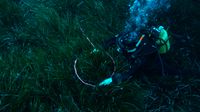
Posidonia meadows as CO2 sink
10 March 2020 published in Frontiers in Marine Science
Reseachers from the Bremen based Max-Planck-Institute for Marine Microbiology together with colleagues from HYDRA measured the oxygen distribution above the seagrass meadows around Elba/Italy. They report the primary production and respiration of Posidonia oceanica, an endemic of the Mediterranean Sea, determined with the non-invasive aquatic eddy covariance technique. According to their findings, P. oceanica meadows are an oasis of productivity in unproductive surroundings. During the night, dissolved oxygen was depleted in the open-water meadow. Generally, these measurements demonstrate that P. oceanica meadows fix substantially more organic carbon than they respire. This supports the high rate of organic carbon accumulation and export for which the ecosystem is known.
Titel of the original publication: Koopmans D, Holtappels M, Chennu A, Weber M* and de Beer D (2020) High Net Primary Production of Mediterranean Seagrass (Posidonia oceanica) Meadows Determined With Aquatic Eddy Covariance. Front. Mar. Sci. 7:118. doi: 10.3389/fmars.2020.00118
New method for microplastic detection
18 December 2019 published online in Applied Physics B
Physicists from the universities of Marburg and Duisburg-Essen around Prof. Dr. Martin Koch, together with HYDRA researchers, tested the potential of photoluminescence spectroscopy to distinguish common plastic polymers from natural polymeric and non-polymeric substances. The spectral signature and their mathematical analysis provided promising results towards the detection and identification of microplastics in natural matrices such as soil and marine sediment.
Title of the original publication: Jan Ornik, Stefan Sommer, Sebasitan Gies, Miriam Weber*, Christian Lott*, Jan C. Balzer, and Martin Koch (2020) Could photoluminescence spectroscopy be an alternative technique for the detection of microplastics? First experiments using a 405 nm laser for excitation. Appl. Phys. B (2020) 126: 15. https://doi.org/10.1007/s00340-019-7360-3
Sweet springs in a salty lake
11 October 2019 published in Hydrological Processes
The Dead Sea is the lowest and saltiest lake on Earth and its water level dramatically falling by 1 meter each year. Situated in a desert climate freshwater springs from far-away groundwater deposits are an important contribution to its water budget. Hydrologists and biologists from Israel and Germany have been studying what they called the 'Springs of Life in the Dead Sea' for years. Yaniv Munwes’ study modeled the discharge of the springs that arise from the lake floor as a jet of lighter freshwater through saturated salt brine in order to better understand the mechanisms and to estimate the overall budget of these freshwater inflows. The model is based on measured data from dives also HYDRA research divers were involved in.
Title of the original publication: Yaniv Y. Munwes, Stefan Geyer, David Katoshevski, Danny Ionescu, Tobias Licha, Christian Lott*, Jonathan B. Laronne, Christian Siebert (2019) Discharge estimation of submarine springs in the Dead Sea based on velocity or density measurements in proximity to the water surface. Hydrological Processes. 2019;1–18. doi:10.1002/hyp.13598

How clams provide fertilizer to seagrass
08 August 2019 published in The ISME Journal
Researchers from Italy, Austria, the Netherlands and the USA together with HYDRA colleagues studied the role of lucinid clams from the shallow-water sands close to seagrass beds of Posidonia oceanica in Fetovaia Bay (Elba/Italy). The role of these bivalves, living in symbiosis with chemosynthetic sulfur-oxidizing bacteria, in the nitrogen cycle was investigated with stable isotope probing and elemental analysis. The symbiosis' carbon fixation rate was found to be 10-fold higher in fall than in spring. Then, the metabolism of the community was carbon limited, which resulted in a 10-fold higher ammonium excretion. This nitrogen compound could be used by the seagrass, giving a productivity boost to this important blue carbon ecosystem.
Titel of the original publication: Ulisse Cardini, Marco Bartoli, Sebastian Lücker, Maria Mooshammer, Julia Polzin, Raymond W. Lee, Vesna Micić, Thilo Hofmann, Miriam Weber* & Jillian M. Petersen (2019) Chemosymbiotic bivalves contribute to the nitrogen budget of seagrass ecosystems. The ISME Journal, 2019. doi:10.1038/s41396-019-0486-9
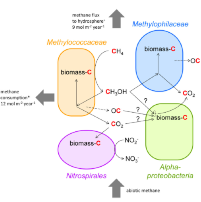
Methane-eating microbes
03 July 2019 published in Environmental Microbiology
Studying the sediments from the methane seeps in shallow water at the coast of Pomonte/Isola d’Elba (I) researchers from the UK, Germany and Denmark together with colleagues from HYDRA found an efficient and well-connected relationship between several groups of bacteria that in a cascade of microbial processes oxidize the potent greenhouse gas CH4 within the top layer of the sediment. An estimated 50% of the methane is thus converted before it reaches the atmosphere. The oxidation products such as methanol and other organic carbon molecules feed a complex trophic network of a specialized microbial community providing an ecosystem function of global relevance.
Title of the original publication: Taubert, M. , Grob, C. , Crombie, A. , Howat, A. M., Burns, O. J., Weber, M.* , Lott, C.* , Kaster, A. , Vollmers, J. , Jehmlich, N. , Bergen, M. , Chen, Y. and Murrell, J. C. (2019), Communal metabolism by Methylococcaceae and Methylophilaceae is driving rapid aerobic methane oxidation in sediments of a shallow seep near Elba, Italy. Environ Microbiol. doi:10.1111/1462-2920.14728
Public talk: Plastic in the environment
14 May 2019 Sinzheim, Lothar-von-Kübel Realschule
Follow-up event for parents: "Plastic in the environment – and what we can do about it" by Dr. Miriam Weber at our local school
After a very successful morning lecture with more than 350 pupils and teachers attending last September, this time it was the parent’s turn. In an evening event Miriam explained the background of scientific plastic pollution studies, and depicted the extent of the problem. Nowadays, plastic is literally found everywhere in the natural environment where researchers have a closer look – in soil, in the rivers and lakes, in the oceans, and also in sea ice or in mountain snow caps. Closing the loop to our everyday life with plastic, and giving concrete measures how to minimize or avoid the linear use of plastic items led to a lively discussion amongst the parents and further interested audience.
Member of the PREVENT Waste Alliance
09 May 2019 Berlin, Official Launching Event
HYDRA Marine Sciences is founding member of the PREVENT Waste Alliance
Federal Minister Müller for Economic Cooperation and Development (BMZ) has officially launched the PREVENT Waste Alliance together with the Indonesian Ambassador and over 30 organizations in Berlin today. The Alliance is part of the Action Program on Circular Economy of the German Development Cooperation. HYDRA is joining the Alliance to connect with different interest groups and to actively participate in the setting up of programs to find solutions. We are adding to the Alliance our expertise in the field of marine sciences and the experience of research on plastic in the environment, from different projects worldwide.
More information: www.prevent-waste.net

Student initiative HD Plastic Free
07 May 2019 Heidelberg, Ruprecht-Karls-University
HYDRA invited for general overview on marine plastic pollution.
One week without plastic. This was the challenging goal over hundred students had set themselves following a social media invitation by their student colleagues. The initiative was launched on Tuesday with an introduction to the topic of the fast-growing problem of environmental pollution by plastic covering different aspects. Besides the presentation by the initiative, and a personal account by a student who tries to life “plastic-free” since more than a year, Dr. Miriam Weber reported from her experience seeing plastic in the ocean every day during her work as a marine biologist, wherever she is diving. This set the frame for a week of reflection, analysis, gatherings and actions the students will live together starting with a presentation of the documentary Plastic Ocean this very evening.
More information: #HDplastikfrei
A worm named after us?
24 April 2019 Published in PLOS One
Colleagues from Sweden described several new species of marine flatworms, also from the Island of Elba. The samples were taken during the international BIOSAND 2010 workshop, organised by HYDRA. We are very honoured that thanks to our colleague Lukas Schärer from the University of Basel two of the new species were named after Miriam Weber and Christian Lott.
Title of the original publication: Atherton S, Jondelius U (2019) A taxonomic review and revisions of Microstomidae (Platyhelminthes: Macrostomorpha). PLoS ONE 14(4): e0212073. https://doi.org/10.1371/journal.pone.0212073
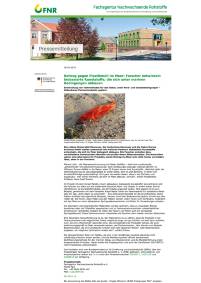
MaBiKu project officially announced
26 March 2019 FNR e.V., the German agency for renewable resources
In applications where the loss of plastic into the envrionment is likely or intrinsic to its use alternative materials are urgently needed to mitigate plastic waste in the sea. In this joint research project, together with their colleagues, HYDRA aims to further develop bio-based plastics that meet the required functionalities and degrade under marine conditions.
Partners MaBiKu is a cooperation between the Leibniz University Hannover, the University of Applied Sciences and Arts, Hannover, and HYDRA Marine Sciences. It is partially funded by the Federal Ministry of Food and Agriculture and will run until 2022.
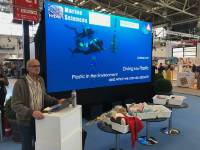
Diving into Plastic
29 November 2018 Munich, Performance Days, Functional Fabrics Fair
Invited expert talk: “Diving into Plastic – A Marine biologist’s view” presented by Christian Lott at PERFORMANCEDAYS
With microplastic from our clothes being found in the environment in almost all water and sediment samples from freshwater and marine habitats the topic is getting more and more attention, also in the textile industry. Being aware of the problem, polymer producers and manufacturers of yarn and fabrics are looking into measures to minimize the loss of microfibers from garment. On what is the specialist fair for outdoor, sports and workwear functional fabrics, the Performance Days in Munich, HYDRA researcher Christian Lott presented an overview of the problem of plastic pollution from the perspective of a marine biologist working in all kinds of waters worldwide. He also informed the broadly interested audience about the latest results of HYDRA’s research on bio-degradable polymers in the marine environment.
More information: www.performancedays.com
Submarine methane seep of abiotic origin
02 November/19 December 2018 published in Applied Geochemistry, and PLOS One
Two new publications: Complementary studies confirm abiotic origin of methane from seeps off the Island of Elba/Italy.
Following several student research projects and field courses, colleagues from Italy, Switzerland, Austria and Germany together with HYDRA researchers studied the gas seeps at the Scoglio dell’Ogliera off the coast of the Island of Elba. Stable isotope analyses confirmed the abiotic origin of the methane gas originating from serpentinized rock in the setting of the Elba ophiolite unit. Just before the methane is finally emitted and leaves the sediment surface in bubbles microbial processes convert this potent greenhouse gas, and cause alterations in the fluid chemistry within the sediment. This leads to the precipitation of carbonate in the porewater binding together sand particles to cm-scale concretions of silicate sand grains in a carbonate matrix.
Original publication 1: Patrick Meister, Johanna Wiedling, Christian Lott*, Wolfgang Bach, Hanna Kuhfuß, Gunter Wegener, Michael E. Böttcher, Christian Deusner, Anna Lichtschlag, Stefano M. Bernasconi, Miriam Weber* (2018) Anaerobic methane oxidation inducing carbonate precipitation at abiogenic methane seeps in the Tuscan archipelago (Italy). PLoS ONE 13(12): e0207305. doi:10.1371/journal.pone.0207305
Original publication 2: Alessandra Sciarra, Anna Saroni, Giuseppe Etiope, Massimo Coltorti, Francesco Mazzarini, Christian Lott*, Fausto Grassa, Francesco Italiano (2019) Shallow submarine seep of abiotic methane from serpentinized peridotite off the Island of Elba, Italy. Applied Geochemistry (100) 2019, p 1-7, doi: 10.1016/j.apgeochem.2018.10.025
Testing marine biodegradation
04./05. November 2018 Berlin, European Bioplastics Conference
“Marine biodegradation test methods"" Dr. Miriam Weber as invited speaker at 13th European Bioplastics Conference
The 13th annual meeting of European Bioplastics e.V., the association of the bioplastic industry in Europe, saw a wide range of participants from all societal groups: experts from producers, manufacturers, national and international public institutions, NGOs and public and private research institutes gathered for an exchange on the status and the role of bioplastics. HYDRA Marine Sciences director Dr. Miriam Weber was invited to give an overview about the progress made in recent years in the field of testing biodegradable plastic under marine conditions. HYDRA has been involved in several public and contracted research projects on this topic since 2009, and has been developing systems for testing materials under natural conditions in Europe and in Asia, directly in the ocean.
More information: www.european-bioplastics.org



